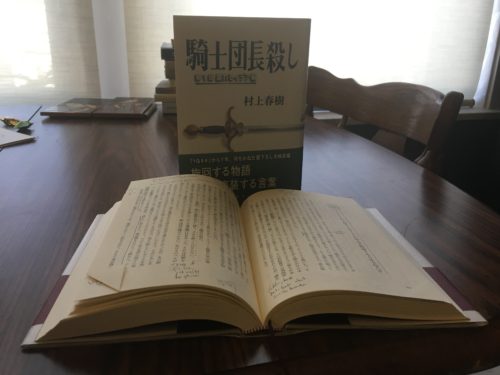I’m in the Japan Times Bilingual page this week: “Conquering ‘Commendatore’: Murakami brandishes familiar lexicon in latest novel.”
Hopefully this is the last I’ll have to deal with Killing Commendatore for a while. I didn’t really have a chance to get down and dirty with the text to illustrate all the thoughts I had about it, but I’m not sure the book deserves such a close look. I still haven’t finished reading the translation of 1Q84, and I’m not sure that I’ll get to Killing Commendatore in English either. 23 days is enough. No más.
But we need to have something for the blog post, so here are the other 惹かれる examples that I didn’t get to talk about in the Japan Times article. I marked this phrase throughout the book. I don’t think this is every instance, but it should give you a pretty good idea how Murakami uses this word.
Sometimes it’s simple—attraction:
私が妻に惹かれたのもまさにその目だった (Watashi ga tsuma ni hikareta no mo masa ni sono me datta, What attracted me about my wife were those eyes).
Here it’s closer to inspire, but attract still feels close; the narrator is talking about some style of painting that no longer inspires him:
私はそのようなタイプの絵画にもう心を惹かれなかった (Watashi wa sono yō na taipu no kaiga ni mō kokoro o hikarenakatta, But that type of painting no longer moved me)
The “Killing Commendatore” painting within the novel attracts the narrator quite a bit, as shown in these next two:
その絵は全体としてまた細部として、私の心をそれほど強く惹きつけていた (Sono e wa zentai to shite mata saibu to shite, watashi no kokoro o sore hodo tsuyoku hikitsukete ita, The painting fascinated me both in terms of its general structure and its details)
And:
とくに私の関心を惹きつけたのは、五人の人物たちが顔に浮かべている表情だった (Toku ni watashi no kanshin o hikitsuketa no wa, gonin no jinbutsutachi ga kao ni ukabete iru hyōjō, The looks on each of their five faces especially interested me)
But in the end, it’s all about the money:
もちろん提示された報酬の金額にも心を惹かれた (Mochiron teiji sareta hōshū no kingaku ni mo kokoro o hikareta, Of course I was also impressed by the amount offered as compensation)
There’s a section with an extended discussion of Harusame Monogatari. Menshiki is particularly interested, as we see:
実を言うと、私はなぜか昔からあの話に心を惹かれてきたのです (Jitsu o iu to, watashi wa naze ka mukashi kara ano hanashi ni kokoro o hikarete kita no desu, To be honest, for some reason I’ve been fascinated by that story for a long time).
But as with many of the other references, Harusama Monogatari drops away pretty quickly.
I just got a comment on my post about my review of the book asking this question:
Considering your negative assessment, why on earth write the other piece, which to my recollection, didn’t even mention anything you wrote in your review? It could be seen as a tacit recommendation of the work, which is not what you wrote in your review.
This is a valid question. I guess the simplest answer is I needed something to write about. I felt like looking at the language Murakami uses would be interesting, and I think these examples do show something about how Murakami looks at the world. I probably should have mentioned something about the review, but the word count was a little tight (<—excuse). But I do feel like I managed to get a little warning about the book in the beginning of the piece. Apologies if anyone feels mislead. If you’re looking for a mammoth Murakami to tackle, I’d recommend his travel journal from his time in Europe, 『遠い太鼓』(Tōi taiko, A Distant Drum). I read half of it at some point when I was living in Japan, but got distracted by life and haven’t gotten around to finishing it. That’s a book that deserves a translation. I’m surprised it hasn’t been rendered in English yet.


